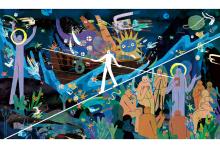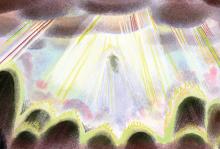Living the Word

THE CENTRAL CHARACTER in Octavia Butler’s short story “The Book of Martha” lives at a time of heightened human oppression and environmental crisis. Martha encounters God, who invites her to help remedy the situation, to make sure “that people treat one another better and treat their environment more sensibly.” Martha’s fear leads her to believe that such an encounter with God was a dream, more likely a nightmare. She insists that it is impossible for her to affect change and asks God to fix things. God replies, “What change would you want to make if you could make only one? Think of one important change.” Perhaps this is a question for all of us.
Martha’s encounter with God turns into something beautiful and allows her to see new possibilities to change the world. Her eventual move toward facilitating the kind of world she envisioned is made possible by her belief in her own agency — her ability to generate novel ideas and take measurable steps to realize them.
Too often justice is described in terms that are broad and abstract. The realization of justice requires concrete steps. Sometimes we despair when we fail to accomplish substantive change, despite our sacrifices and work. This is part of the human condition. But we are also called to actively hope and then take the steps that are ours to take. An alternative reality is possible when we allow ourselves to be transformed by God’s presence working in earlier models of liberation. We are invited to think creatively together about what is possible and pursue it passionately.

THERE IS A saying in Telugu, my mother tongue: “The fence has devoured the garden.” I find it a useful phrase in this year when the United States embarks on a federal election cycle that will test the strength of our democratic institutions and may well damage their integrity. The same leaders entrusted with the power to safeguard the interests of the people (“the fence”) have instead undermined them. Growing economic inequality continues to dehumanize individuals and entire communities. Women, Black, brown, refugee, and LGBTQ people increasingly feel at risk in light of recent court rulings. Leaders expected to provide vision in times of crisis, whose mission is to “protect the garden” of democracy and civil life, appear to be actively “devouring” it. And accountability has been in short supply.
How do we facilitate transformative changes that allow individuals and communities, especially those at the margins, to realize their dreams and flourish? At a time when scriptures (such as Romans 13) are used to prescribe uncritical loyalty to authorities, what are some strategies for holding those authorities accountable? This month’s texts invite us to identify and nurture leaders who can see things differently, offer a generative vision, and undertake radical changes. They exhort us to empower a new generation of leaders who are working collaboratively and serving the people with integrity, and who privilege the interests of the community over their own.

“THE CONTEMPLATIVE ON her knees well knows the messy entanglement of sexual desire and desire for God,” writes theologian Sarah Coakley. If she’s right, then attending to what arouses us sensually can teach us something about how God lures us through our longing and, even, how we can attract God’s intimacy. This month, we’re exploring how queer theology can invigorate (dare I say, stimulate?) the anticipation we build throughout Advent. This approach may seem blasphemous to some who aren’t familiar with a queer-affirming lens ... and perhaps uncomfortable to some who are. Many of us are steeped in Christian body-denying theologies and moralities. We are uncomfortable meeting God in ways that are playful, erotic, unnerving, and always cognizant of power dynamics (though scripture is steeped with such sexual innuendo). Queer theology starts from (rather than argues for) not just queer affirmation, but queer celebration. It can expose the erotic dimensions of our sacred stories to reveal God’s wild and promiscuous desire for all creation.
December is a season for sending Christmas cards depicting the Holy Family — perhaps the most heteronormative image in the church year: A mom and dad stare lovingly at their beautiful baby. This static image can obscure the mess of desire, power, submission, and surprising gender fluidity required to incarnate this Holy Child. What moves in us as we ponder the design of different Christmas images that don’t shy away from this beautiful mess? What images help us face the wonder and terror of what it feels like to be undone and remade by God’s overcoming?

ACROSS THE UNITED STATES, people will soon be preparing for Thanksgiving. We’ll name what we’re grateful for and then, in an ironic turn, let “Black Friday” convince us we need more. “Cyber Monday” will catch all the credit cards that made it, un-maxed, through the weekend. “Giving Tuesday” lets us pay the virtue toll to keep spending guilt-free on the yet-to-be-named following Wednesday. Whew! The consumerist drive in November and December makes the temporality of liturgical living difficult. But let’s try. November marks the end of both Ordinary Time and the church year. Ordinary Time is the day-in, day-out rhythm of everyday life as we await Christ’s second coming. In these final weeks, we’re not quite waiting on Christ, then — as we do during Advent — so much as we’re preparing ourselves to wait.
Come Advent, the scripture readings will be filled with anticipatory hope. But, as the old church year ends, the passages are full of anxiety and dread. The Hebrew Bible selections spotlight the escalating threat of the coming judgment. Paul’s letters pour out end times panic. Or, as songster Leonard Cohen put it, “Everybody knows it’s coming apart.” In Matthew’s gospel, Jesus forces us to ponder which side we are on. It’s not easy to sit with all this. I want to skip over to Advent hope (or even Christmas joy). But I invite us to hospice the old year’s death throes before welcoming new life at the stable door.

IN 2012, a group of scientists from the University of Washington discovered Y chromosomes in the autopsied brains of female cadavers. Finding so-called male DNA in cis women’s bodies certainly complicates our notions of gender! But the focus then was on introducing the sci-fi-sounding concept of fetal microchimerism. Fetal cells, we learned, can remain integrated at the genetic level in someone’s body long after the fetus or baby is not. These cells can be passed on to future siblings, thus embedding visceral relations within our bodies that even the most adept family-systems theorist would struggle to disentangle.
The scientific community labeled this a discovery. But for anyone already skeptical of the mind-body dualisms in Western culture, this was simply science catching up with how we already experience our ancestral relations. Intergenerational wisdom and trauma aren’t simply intellectual concepts. Rather, our ancestors’ presence in our lives connects at sites where body, spirit, mind, and soul inextricably intertwine. And these sites are in desperate need of some decolonizing attention if we’re to reclaim our ancestral relations in our practices of Christian faith. Of course, that might not be something we all want to do. But this month, I’ll engage the lectionary readings through this lens to see what questions and insights might arise. And I’ll do so with the hope that our wide, wondrous communion of saints will read along with us.

SEVERAL OF THIS month’s lectionary readings deal with the tensions of navigating wrongdoing, judgment, vengeance, and forgiveness. They call readers to forgive — and forgive again: not just once, twice, or seven times, but at least 77 times and counting (see Matthew 18:22).
These texts have been used throughout history to trap people in positions of disempowerment, abuse, and enslavement. Consider, for example, how victims of intimate partner violence have been pressured to forgive and return to their abusers, who then proceed to hurt them again. Or how entire marginalized communities are expected to “get over it,” whether that is the colonization of Turtle Island, enslavement, or generations of misogynist, queer- and transphobic policies, laws, and violence. In light of the rampant misuse of these texts, we’re right to be wary of biblical interpretations for how to handle conflict that reinforce domination. The texts tend not to deal directly with inherent interpersonal and structural power dynamics. We must do that work ourselves. Any of us preaching the lectionary this month must also be careful.
Attending to the power dynamics of these passages doesn’t mean we dismiss them as useless. Rather, such attention helps us discern how these texts invite and bear witness to God’s presence in processes of interpersonal, intergenerational, and even international healing. They call us to attend to what our own pain has to teach us and to seek hope through community life. And they promise that throughout our attending, God will abide — waiting patiently to see us through.

JEWISH NEW TESTAMENT scholar Amy-Jill Levine claims that all religions are a little bit supersessionist. Christian supersessionism — which understands God’s covenant with Christians to nullify God’s covenant with the people of Israel — has been so mainstream throughout most of Christian history that it has hardly required articulating. It was just the anti-Jewish water in which we swam. Following the Holocaust, however, Christians recognized how much we’d weaponized supersessionism into antisemitism, which provided support for Nazi and white supremacist ideologies and perpetuated anti-Jewish violence. Unfortunately, Levine argues, no exegetical maneuver can fully expunge supersessionism from the New Testament — though many have tried. It’s there. And the authority of God’s word in Christian lives keeps its dangerous power ever-present.
Still, Paul’s letter to the church in Rome (which we read this month) contains Paul’s own grappling with these questions. Chapters 9 to 11 — wherein Paul corrects some of the Gentile converts who think God has now rejected the covenant with Israel — comprise the hook on which most contemporary attempts to dismantle supersessionism hang their hat. So, we’ll pay special attention to these.
This isn’t going to be an easy fix — particularly for Christians (like me!) who want to hold fast to the gospel, atone for complicity with antisemitism, and stand in solidarity with Palestinians under occupation. Still, I trust God’s promises: I believe both that God’s covenant with Israel endures and that Jesus is the Messiah. So, this month, we are going to sit with the discomfort of failing while attempting the impossible. Because, in trying, we might find a new way through.

BEFORE THE PANDEMIC hit, I could have told you the precise number of my indoor plants: zero. But then lockdown started and, like countless people around the world, I became obsessed with all things leafy and green. Once I learned how to keep a plant alive, I began to nurture cuttings. To see that first fresh leaf grow — an assurance that new roots had taken hold — filled me with a kind of joy heretofore unknown.
I needed to feel like life could not just survive, but flourish and thrive. “Give this at least six weeks before repotting,” I would text a friend from her porch as I dropped off the gift of a budding leafy monstera, “just to let the roots settle.” Then I’d trudge back to the sidewalk to watch my friend open her door, wave to me, and take this small extension of myself into her home. Months later, when we could visit in person, I’d get to see how much these little ones had grown. Great leafy extensions of love.
Most of the gospel readings this month contain horticultural parables — seeds and soil, wheat and weeds, sowers and reapers. Before the COVID-19 years, I had never read these parables through the eyes of someone who had nurtured plants to life. Their images had been abstractions, ideas, metaphors with no roots. But now that those seeds have grown, I see each one anew. Perhaps you do too?

WE HAVE SEVERAL readings this month where God creates something out of nothing — or at least out of pretty limited materials. In the opening chapters of Genesis, we see creation birthed from God’s imagination and curiosity. In the story of Sarah and Abraham, a child is conceived in a womb so postmenopausal that the now-pregnant woman can’t help but laugh (Genesis 18). A well appears from nowhere to quench the thirst of a dying woman and her child (Genesis 21:19). God “calls into existence the things that do not exist” (Romans 4:17). And God turns death to life through the mysteries of resurrection (Romans 6:1-11).
This month’s lectionary readings make God’s continuous creation — as well as God’s continual renewal of creation — explicit. But the fact is, once we’re looking for it, all of scripture tells these stories of renewal. God is always creating, re-creating, and reimagining our world. God is always making a way where there was no way before. God continually turns death to life. And, just as importantly, we are called to participate in God’s divine practices of continuous creation, in God’s own divine practice of everyday resurrection.
As we exit a series of some of the higher holy seasons in the liturgical year — Epiphany, Lent, Easter, and Pentecost — June quiets down from such intensity. The slower pace to which (in some places) the warm summer sun calls us can inspire us to seek out everyday resurrection wherever God hides it. How is the Spirit calling you to partner with divine practices of renewal, with everyday resurrections?

MOST OF OUR gospel readings in May move through sections in John’s gospel commonly referred to as the “farewell discourse.” In this long goodbye, Jesus and his disciples have finished eating their last supper together. Judas has departed to betray his friend. Now it’s time for Jesus’ final words to the remaining 11. Or, at least, it’s time for him to say goodbye from the perspective of who they’ve known him to be thus far. He’s preparing them for who he is becoming, as well as how he’ll continue to be among them — and, by extension, among us. There’s a lot that Jesus wants to accomplish without fully tipping his hand. So, his speech is at times confusing!
Unsurprisingly, a sense of longing permeates the whole address. These friends are saying goodbye to each other while also scrambling for ways to stay together. Jesus is grieving that goodbye, while also anticipating a joyful return to his Abba in heaven. As he speaks, then, Jesus tells of a fluid, swirling kind of love that permeates and connects God, himself, and his followers all to each other. This fluid love is the Holy Spirit that Jesus will “breathe” upon his followers (John 20:22) — the Holy Spirit who lingers among us still.
Our celebrations at Pentecost tend to focus on the wild descent of fiery tongues upon the early Jesus community — as they should. But in this lectionary cycle, the New Testament readings don’t focus on wind, fire, or tongues. Instead, they have us abide in these less dramatic, more subtle, ambiguous, and mysterious moments. This year, Pentecost calls us to abide in and with a love that often doesn’t make sense, but that always must be shared.

IN 1633, THE Bavarian village of Oberammergau experienced a miracle. The villagers had promised God they would stage a reenactment of the passion of Christ if they were spared from the plague. They were spared. Nearly 400 years later, people continue to come from around the world to see these performances. But there’s a problem. Oberammergau’s passion play is one of the most antisemitic artworks in European history. Adolph Hitler viewed the play in 1930 and 1934 and recognized its propaganda value for his own plan of Jewish genocide.
Christians today may still perpetuate anti-Jewish racism throughout our passion narratives — particularly when the gospel of John forms the core of the lectionary. Unlike the others, John’s gospel frequently labels anyone opposing Christ as “the Jews.” Most of us realize that the writer is naming a subset of religious leaders. But when we repeat the phrase throughout Easter, we can subconsciously reproduce and amplify antisemitism found in the Christian theological imagination.
Recently, rather than ignoring the passion play’s antisemitism, the director worked with the American Jewish Committee to rid the play of anti-Jewish tropes. The 2022 Oberammergau passion play told a more complete Easter story. “The Jews” now include Jesus and his followers too. Jesus lifts a copy of the Torah to pray the Sh’ma Yisrael. Hebrew prayers were recited over the Last Supper. Mary is greeted as the “rabbi’s mother.” Significantly, the updated version calls Christians to repent for how we’ve failed our foundational sibling relationship.

MY SEMINARY PREACHING professor used to say that we should only tackle one of each week’s lectionary texts in our sermons, maybe — just maybe — tying in a second. Over the course of a career, a great preacher might have a couple of three-text sermons in her. But only a foolish preacher tries to preach all four. The problem with this month’s readings is that they contain a lot of four-text temptations. Their cumulative effect, though, tends toward incarnation: not just God enfleshed in Jesus, but God enfleshed in us all and, even, in all creation.
By the end of the month, Lazarus will be raised from the dead (John 11:1-45). He and his sisters, Mary and Martha, were among Jesus’ closest friends. So, it seems odd to me that when Jesus first hears the message that Lazarus is ill, he seems to shake it off (verses 3-4). I wonder if Jesus was surprised, then, when he learned that Lazarus had died (verse 32). I wonder if he was shaken, suddenly uncertain about his certainty. Later, Lazarus’ resurrection prefigures Christ’s own rising again in glory. But at this point in the story, we don’t yet know that life is coming. All we can see is death.
That’s the risk of incarnation; it’s the risk of not knowing. And that risk is why I find this story (and the arc that leads to it) so comforting. My comfort comes not just in knowing that Lazarus came back to life. More so, my comfort comes in knowing that, like us, Jesus — God in flesh — risks not quite knowing the way to and through the ending.

WITH THIS MONTH'S liturgical arc, we move from Epiphany to Lent: from a season of illumination to one of penitence. You’d think they would be reversed, though. You’d think it would be necessary to do the soul-searching first, to clean house before we get to invite God over for tea.
But the natural order of things always becomes topsy-turvy when God gets involved. God’s time “doubles back and loops around and ends up looking something like ... the name ‘Jeremy Bearimy’ in cursive English,” as Michael (Ted Danson) explains to Eleanor (Kristen Bell) in television’s The Good Place. The dot over Bearimy’s “i” represents Tuesdays, July, and “when nothing never occurs.”
Joking aside, this is the gift of the liturgical calendar: It lets us glimpse what it’s like to live in God’s time rather than our own. We don’t need to be worthy of an encounter with God before that encounter can happen because we constantly live in the kingdom space of already-not-yet. Revelation and repentance are like the proverbial chicken and egg: No one really knows which comes first, and it probably doesn’t matter in the end.
Divine time’s topsy-turvy nature is also why Christians are called to discern the difference between the “wisdom of this age” and God’s wisdom (1 Corinthians 2:6-7). What this month’s readings might call us to ponder, then, is not where human and Divine wisdoms diverge but, rather, where on Jeremy Bearimy’s curves they converge. Perhaps even on the dot of the “i.”

JANUARY OPENS THE season of Epiphany: In the North, the light begins to last longer, and we reawaken to the world outside our doors. Each Jan. 6, my family performs the old European Epiphany ritual of “chalking the door” to our home. While I pray, my spouse hoists our kids up to write the blessing on our front lintel. This year the markings will look like this: 20+C+M+B+23. Twenty marks the beginning of the year. The letters recall the Magi (Caspar, Melchior, and Balthazar) whose visit we celebrate and also the Latin prayer: Christus mansionem benedicat (“May Christ bless the house”). The final number closes out the year. The markings are strange. We’re asked about them often. We recall the great light that led the people out of Egypt, the great star that guided the Magi, and the Holy Family’s hospitality. These signs keep evil spirits out and invite God’s Spirit in. And that’s a lot to explain to the FedEx guy.
But Epiphany is a lot! It invites us to explore the complex roles we play in God’s redemption: our complicity in evil as we reach for the good, our relationship to violence, and how we’ll practice hospitality post-COVID.
In this season we also travel with the community of Jesus-followers at Corinth. Much like them, Christians today have become increasingly divided — even among those who agree on the values of compassion, community, and caring for those most vulnerable. The pandemic has made it difficult to find a vision for how to live out our shared values. What striking illumination will this season bring?

A FEW YEARS ago, I set out to knit a baby blanket as an Advent prayer practice. Knitting is incredibly meditative and allows me to pray with focus and clarity. Knitting a baby blanket seems appropriate as the church awaits the arrival of the “newborn king.” I wish I could say I finished the blanket in time for Christmas. I did not. However, even that seems appropriate, as so much remains unresolved for Jesus’ community at his birth. Their political occupation continued, and even Jesus’ birth story reflects the impositions placed upon his family by the Roman Empire. God’s inbreaking happens under serious duress — but it happens nonetheless.
My favorite lines from the poem “Christmas is Waiting to be Born” by Howard Thurman are: “Where fear companions each day’s life, / And Perfect Love seems long delayed. / CHRISTMAS IS WAITING TO BE BORN: / In you, in me, in all [hu]mankind.”
Thurman reminds us that God was born into our sorrow and among those who are brokenhearted and struggling. That truth is so important to hold on to as we process years of our own collective trauma. No matter how unresolved things are, Christmas is born in us, too! In December we continue our journey through Advent and arrive at Christmas. We might not have received what we’re waiting for by that time, and very little may make sense. Yet, because of who God is, we open our hearts to the improbable, trusting that we won’t be put to shame.

WE ARE APPROACHING the end of the liturgical year, and the texts have a thread of anticipation running through them. We are deep into the promises conveyed by the prophets and the eschatological vision cast by Jesus. The texts are inviting us to prepare ourselves for something — but what, exactly?
The last Sunday in November, in many traditions, is the Advent Sunday of hope. In biblical Greek, the verb is elpizō (“hope”), which means to wait for salvation with both joy and full confidence. When we hope, we wait not out of boredom or a lack of options but in full confidence that what we are waiting for will arrive. This is the same word used in Hebrews 11:1, “Now faith is the assurance of things hoped for, the conviction of things not seen.” The word “assurance” here can also be translated as “foundation,” as in that of a house. Faith is what anchors our hope into the ground and allows it to stand upright. Faith also often requires that we act before we see. Our hope is first materialized in our faith before it is ever materialized in our reality. Hope pushes us to walk, move, and live as if what we’ve hoped for has already arrived.
Perhaps this moment calls to us to build foundations for the futures we need in defiance of our present realities. Our texts dare us to live into new possibilities, even as our current condition offers far fewer promises.

PUBLIC EDUCATOR AND philosopher Cornel West has spoken about the difference between optimism and hope. Optimism, as he understands it, can point to empirical evidence that suggests things will get better, while hope can exist without any of that. Even when nothing around us points to a bright future, hope defiantly holds on for a better day. Baptist minister and social ethicist Miguel A. De La Torre argues in his book Embracing Hopelessness that hope is often used as a tool of oppression and pacification. For him, hopelessness can be an animating force for justice because a deep enough dissatisfaction with the status quo will move us to change it.
I find resonance and challenge in both of these dear teachers’ perspectives. Very little of our time suggests that things are progressing the way they should. The status quo is untenable and must be changed. Both perspectives remind us not to trust or be satisfied with the way things are. We must find motivation to build the world we need rather than accepting the one we have. For many Christians, October begins with World Communion Sunday and ends with All Hallows’ Eve and Reformation Day. We celebrate our eucharistic ties to Christians around the world, recognize the great cloud of witnesses and saints who have gone before, and commemorate one of the many movements in church history that have pushed us toward something new. We live in a time when very little resembles what we knew just a few years ago. How might our texts help us build for what is coming?

IN HER BOOK The Great Emergence, the late Phyllis Tickle pointed out that the church undergoes a “rummage sale” about every 500 years in which dominant forms of its spirituality are displaced from prominence by newer forms of spirituality. It’s much like a purge one would have when decluttering a home or preparing for a move. Older forms of spirituality aren’t done away with; they simply are no longer dominant. New things come to the forefront.
By the fourth century, the locus of Christianity had shifted from ancient Israel and Syria to a Christendom based in European and Western civilization (though a thriving Eastern church remained and does so today). About 40 years ago, another shift occurred. Now there are more Christians in the Global South than in Europe and North America. And Christianity continues to wane in the West. To the extent Christianity has accompanied colonial expansion, I believe this too is a kind of purging. Many of us wrestle with church doctrines and practices that have been in service to domination power for a long time but are untenable in a just world. Who God needs us to be today is markedly different from whom we’ve been in the past.
This month’s texts call to mind the words of the liberation song: “They say that freedom is a constant struggle. Oh Lord, we’ve struggled so long, we must be free, we must be free.” Freedom is not a static destination. Freedom must be maintained, much like the state of a house. Whatever God is calling us toward today, it won’t be necessarily familiar or even pleasant, but it will make us free.

YOU, FAITHFUL CHURCH workers, have survived the demands of Lent, Holy Week, Easter, and Pentecost, and I’m willing to wager you are tired. By this time in the liturgical cycle, I’m usually exhausted and my spiritual (and sometimes physical) walk includes a pronounced limp. Vocational and social demands have taken their toll, not to mention the profound collective trauma we have all been through. Two years ago this summer, the waves of direct action in response to the police killings of Breonna Taylor and George Floyd left many of us particularly drained. And the shootings have not stopped. We have all done and been through so much.
Throughout the New Testament, the text refers to faith using the Greek word pistis. That word can also translate as faithfulness, a dogged determination that refuses to acquiesce or let anyone stifle it. It’s the same faith exercised by the woman with the flow of blood and shown in the litany of ancestors in Hebrews 11. It is more than sentimental, and sometimes is best exercised by simply being still and remembering who God is.
Our scriptures this month encourage us to exercise and examine our faith so that we keep going forward, even if we must stop and reset ourselves. Whether our posture is active or passive, our faith is still called into action because the world needs our witness.

MY PARENTS WERE raised watching Westerns in which the tropes were all the same: There were “good guys” and “bad guys.” I was raised on Disney movies with similar tropes. There was little moral complexity in these stories, which I suspect reflects our tendency to look at the world in terms of a good/bad dichotomy. Reality is much more nuanced. I appreciate the way that popular 21st-century movies have embraced some of that nuance. One example is the Oscar-winning film Crash, a complex racial narrative released in 2004. An antagonist police officer in the movie’s opening becomes a hero by the end, while his idealistic partner takes the inverse path. It’s never totally apparent who the “villains” and “heroes” are. While I think our investment in the good/bad dichotomy is still substantial, it seems popular culture might agree with the psalmist who says, “there is none who does good” (Psalm 14:3).
Our willingness to accept human complexity is key to our ability to reshape ourselves into more just communities. Today, we see state legislatures seeking to prohibit educators from teaching uncomfortable truths about our country’s past because of the dominant culture’s inability to confront that truth. I remember the words of James Baldwin: “Not everything that is faced can be changed; but nothing can be changed until it is faced.” The scriptures for this month help us change what needs to be changed by facing it and trusting in God’s ability to move us forward.